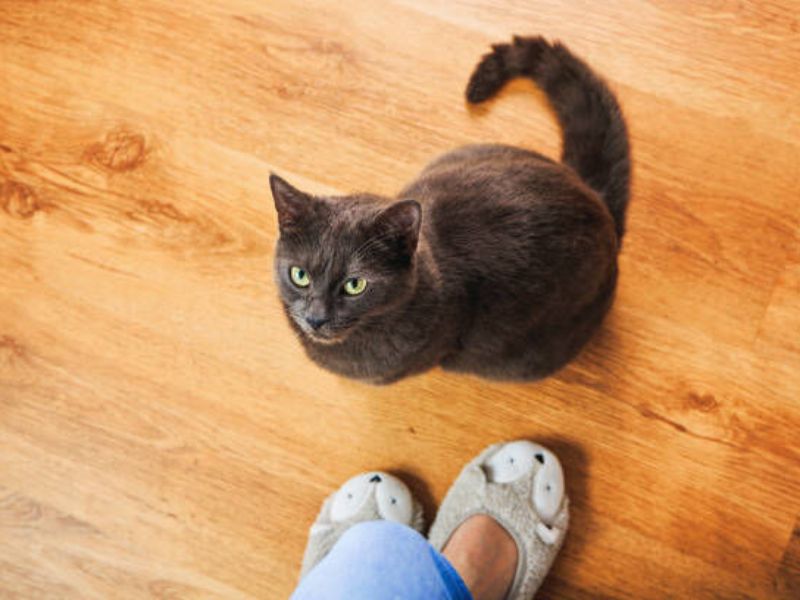Ever feel like your cat practices invisibility spells? You call their name, but only silence answers. Wouldn’t it be amazing if you could simply say, “Come here,” and have your furry friend materialize at your side? The good news is, you can! This guide will tell you how to train a cat to come, transforming those frustrating chases into joyful reunions. Let’s scroll down and get ready to train your kitty with Canvas Personalized!
Preparation before training
Before you dive into training sessions, a little preparation goes a long way in keeping your cat engaged and happy. Here’s what you’ll need to set the stage for success:
- Choose the reward: Think of tiny pieces of cooked chicken, tuna, or freeze-dried treats. These irresistible morsels will make your cat eager to come running. However, not all cats are food-motivated. So, consider using a favorite toy for a quick play session or a few enthusiastic head scratches as a reward.
- Pick a consistent cue word: Choose a one- or two-syllable word that’s easy to say clearly. Examples include “come,” “here,” or even your cat’s name. You can also say something like, “Ki-ki-ki!” in a high-pitched voice. You can make a clicking or squeaking noise. A whistle may also work.
- Find a positive environment: Find a quiet, distraction-free area in your home for the training sessions. This will help your cat focus on you and learn more effectively.

How to train a cat to come: Step-by-step guide
Step 1: Establish a positive connection between the sound and the reward
No matter your chosen reward (treats, toys, pets), the key is to create a positive link with your cue word. Say the cue word “come” or call your cat’s name and then immediately offer the reward. This creates a happy association, making your cat more likely to approach you when they hear the cue.
Bonus Tip: If you’re using food rewards, a cat’s hunger can be your training ally! Schedule training sessions around 15 minutes before mealtime. This taps into their natural desire for food, making them extra motivated to come when they hear your cue word.

Step 2: Call your cat and then offer a reward
Now that your cat associates the cue word with a reward, it’s time to put it into practice! Start by standing a few feet away and say your cue word clearly. Show the reward (treat bag, favorite toy) to grab their attention. The moment your furry friend approaches, shower them with praise and the chosen reward.
Cats live in the moment, so reward them immediately when they respond to your cue word. This creates a clear link between their action (coming to you) and the tasty treat (or other reward). Don’t wait too long, or they might miss the connection and become confused.

Step 3: Gradually increase the distance
Once your cat masters coming from a short distance, it’s time to expand their skills! Gradually increase the gap between you when calling their name. Try calling them from different rooms in the house, even when they’re distracted by something else. Remember, the goal is for your cat to respond in various situations. By mixing up the distance and environment, you’ll solidify the “come” command and build a reliable response.
Want to take your training up a notch? Consider using a clicker! Clickers are handy tools that help mark the exact moment your cat performs the desired action (like coming to you). Experts find them effective for cat training, especially when paired with treats.
Here’s how to train a cat to come with a clicker:
- Call your cat’s name to get their attention.
- Use your cue word (“come”).
- The moment your cat starts approaching, click the clicker.
- Immediately offer the treat.
Over time, your cat will learn to associate the click with the upcoming reward, making training even more precise!

Step 4: Slowly fade out treats
As your feline friend reliably responds to your call, it’s time to mix things up with rewards! While treats are great motivators, too many can lead to weight gain. Plus, you won’t always have a treat handy. So, you should gradually wean them off treats.
Start by giving the treat they love 3 out of 4 times they respond to your call. Over time, slowly decrease the frequency to half, then a third, and so on. You can alternate treats with belly rubs, ear scratches, or any other form of affection your cat enjoys. This keeps them engaged and reinforces the behavior, making them more likely to come running even without a treat in sight!

Tips to train a cat to come when called
Start young
Young cats have a tendency to learn more rapidly. So, it is ideal to start training your cat when she is a kitten. Nevertheless, many pet parents choose to adopt cats in their later years. Age is no barrier to learning. It might just require additional time.
Keep training sessions short.
Cats are naturally curious creatures, but their focus can easily fizzle out. Short sessions (around 2-3 minutes) ensure your cat doesn’t get bored or frustrated, allowing them to stay engaged with the training task.
Never punish your cat.
Remember, cats thrive on positive reinforcement. Punishing them for not coming when called (even if it’s frustrating) is counterproductive. They won’t understand the connection between the punishment and their actions. Instead, it can make them stressed or unhappy, further hindering the training progress. Keep things positive, shower them with praise when they respond, and they’ll be much more likely to learn and bond with you!

Reward your cat even if they react slowly.
Don’t get discouraged if your cat doesn’t come running right away. It takes time for them to connect the cue word with the reward. The key is consistency! Reward your cat every time they make an effort to come, even if it takes a few moments. This strengthens the positive association with your call, making them more likely to respond quickly the next time. Remember, training is a journey, not a race. Stay patient and celebrate every step along the way.
Only use your command in positive situations.
We want your cat to associate the “come” cue with happy things, not stressful situations. So, avoid using it when you need to take them to the vet or give them medicine. Instead, calmly approach your cat in these situations. This way, “come” remains a positive word that signals playtime, treats, or cuddles, keeping your cat happy and more likely to respond whenever you call.
>>> Read more:
- How to Teach a Cat to Fetch in 6 Easy Steps?
- How to Teach a Cat to Sit Quickly with 2 Ultimate Methods?
Congratulations! You’ve figured out how to train a cat to come! With consistent practice and positive reinforcement, your cat will soon be by your side whenever you call. Not only will this strengthen your bond, but it can also bring peace of mind, knowing you can easily locate your furry friend. For more cat training tips, don’t forget to check out Canvas Personalized!










